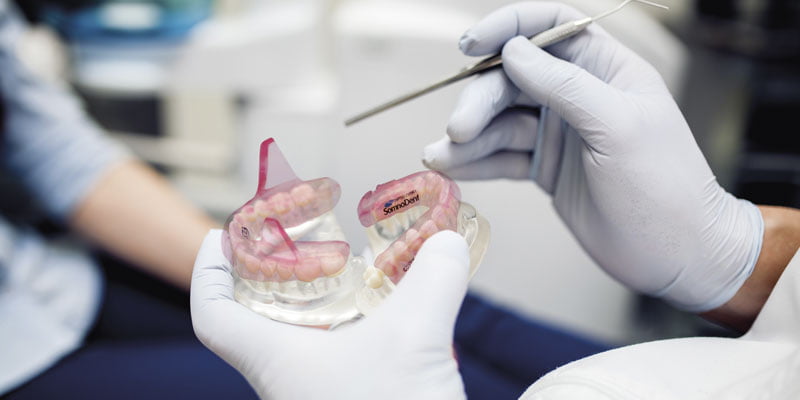Colonel Scott Williams says more research is needed to showcase the benefits of mandibular advancement therapy for OSA.
 by Colonel Scott Williams, MD, FAASM
by Colonel Scott Williams, MD, FAASM
When one considers treatment of sleep disordered breathing, the first therapeutic modality that likely comes to mind is positive airway pressure (PAP). In fact, some clinicians think that it is the only option available to patients. In order to increase the awareness of mandibular advancement therapy (MAT), high quality research is critical. A quick PubMed search with common key words (mandibular advancement device, oral appliance, etc.) shows that just over 3,000 articles have been written about MAT, compared with almost 12,000 for CPAP. Broadening the search term to “positive airway pressure,” the number jumps to over 20,000. The dental/orthodontic literature base is robust, however. A search for “oral appliance” yielded almost 50,000 results, but when general orthodontic/prosthodontic articles are excluded, only about 1,500 articles remain. For the most recent American Academy of Sleep Medicine Clinical Practice Guideline regarding MAT, only 377 citations met criteria for inclusion.1
This research disparity has important ramifications, especially considering the rapid dissemination of information via media that would have been considered unimaginable even just a few decades ago. Whereas historically, research articles were relegated to medical libraries and read only by those who had institutional access, nowadays results are shared over social media platforms, traditional and digital news outlets, and “go viral” very easily. What follows are a few examples of simple yet impactful research that many dental sleep practices are able to (and should) replicate.
“It is essential to remind the scientific and lay community of the benefits of MAT, specifically the cardiovascular impact.”
First, its helpful to highlight the need to change perceptions regarding the patient population that might benefit from MAT. Most feel that MAT is contraindicated in severe OSA but there is some emerging data showing that some patients can be adequately treated, and that device design may play an important role in relative effectiveness.2 PAP manufacturers have long been experimenting with a variety of design improvements to include auto-adjusting algorithms, transient expiratory pressure decrements, and adjustable humidification. Mask technology is also constantly evolving, and with each new iteration there is usually published literature showing a benefit. Very few published data compare the relative advantages of newer mandibular advancement device (MAD) technologies, so the study by Vanderveken and colleagues should serve as a template for future work. It is crucial for independent groups to validate initial industry-funded trials, however, to increase the confidence of the findings.
Second, it is essential to remind the scientific and lay community of the benefits of MAT, specifically the cardiovascular impact. While it has been known for more than 20 years that MAT can decrease blood pressure,3,4 CPAP has consistently been thought of as superior to MAT. A recent study by Thant and colleagues underscored the important difference between efficacy and effectiveness.5 In Thant’s study, MAT therapy was non-inferior to CPAP (and actually showed a marginally greater reduction in BP), likely mediated by greater use of MAT vs. CPAP. In this study, 74.7% of patients used the MAD more than 6 hours per night, compared with 56.5% of patients in the CPAP group. The importance of reporting nights of full usage, not just nights with greater than 4 hours use, is critical for OSA trials. A concerning number of CPAP trials have fallen short of reversing the many physiologic changes seen with sleep disordered breathing. It’s not because CPAP doesn’t work, its because there is a dose-response curve, and this is where MAT can show superior outcomes…if it is studied.
Finally, much more research is needed in the area of stepped care or combination therapy. Surprisingly little data exists in this area, and where it does, the data quality is variable. That said, the outcomes are usually very good. Aishah and colleagues conducted a very nice study looking at mandibular advancement in combination with positional therapy, pharmacotherapy, and other modalities.6 Other studies have looked at the role of alternating between CPAP and MAT to mitigate jaw discomfort and to provide options for patients who travel frequently. However, these trials are typically small, sometimes underpowered, and have inconsistent outcomes.
In my clinic, I often see patients who are new to me and are struggling with CPAP. Almost without fail they have not been offered a mandibular advancement device and most are unaware that it is an option. In fact, more patients are aware of hypoglossal nerve stimulation than MAT. It is imperative for the Dental Sleep Medicine community to increase the pace of research in order to more fully demonstrate the benefits of this treatment option.
For more information about assessing and discussing individual patient considerations for mandibular advancement therapy, read this article by Dr. Donald R. Tanenbaum. https://dentalsleeppractice.com/mandibular-advancement-devices/#Jaw_Function_Comfort_and_Occlusion
- Ramar K, Dorr LC, Katz S, et al. Clinical practice guideline for the treatment of obstructive sleep apnea and snoring with oral appliance therapy: an update for 2015. J Clin Sleep Med, 11(7), 773-827, 2015.
- Vanderveken OM, Van Daele M, Verbraecken J, Braem MJ, Dieltjens M. Comparative analysis of two custom-made mandibular advancement devices with varied designs for treating moderate to severe obstructive sleep apnea. Sleep Med, 117:95-98, 2024.
- Gotsopoulos H, Kelly JJ, Cistulli PA. Oral appliance therapy reduces blood pressure in obstructive sleep apnea: a randomized, controlled trial. Sleep 27(5):934-41, 2004.
- Bhushan A, Tripathi A, Gupta A, Tripathi S. The effects of an oral appliance in obstructive sleep apnea patients with prehypertension. J Dent Sleep Med, 2(2):37-43, 2015.
- Thant AT, Shih EC, et al. Mandibular advancement vs CPAP for blood pressure reduction in patients with obstructive sleep apnea. J Am Coll Cardiol, S:0735-1097(24)00906-9, 2024.
- Aishah A, Tong BKY, Osman AM, et al. Stepwise add-on and endotype-informed targeted combination therapy to treat obstructive sleep apnea: A proof-of-concept study. Ann Am Thorac Soc, 20(9):1316-25, 2023.





 Colonel Scott Williams, MD, FAASM, is the director of the Center for Military Psychiatry and Neuroscience at the Walter Reed Army Institute of Research. Dr. Williams received his medical doctorate from the Uniformed Services University of the Health Sciences. He completed a dual residency in Internal Medicine and Psychiatry at the Walter Reed Army Medical Center with fellowship training in Sleep Disorders Medicine at the Walter Reed National Military Medical Center. He has served on numerous committees within the AASM and AADSM, and remains passionate about furthering the interdisciplinary nature of sleep medicine.
Colonel Scott Williams, MD, FAASM, is the director of the Center for Military Psychiatry and Neuroscience at the Walter Reed Army Institute of Research. Dr. Williams received his medical doctorate from the Uniformed Services University of the Health Sciences. He completed a dual residency in Internal Medicine and Psychiatry at the Walter Reed Army Medical Center with fellowship training in Sleep Disorders Medicine at the Walter Reed National Military Medical Center. He has served on numerous committees within the AASM and AADSM, and remains passionate about furthering the interdisciplinary nature of sleep medicine.